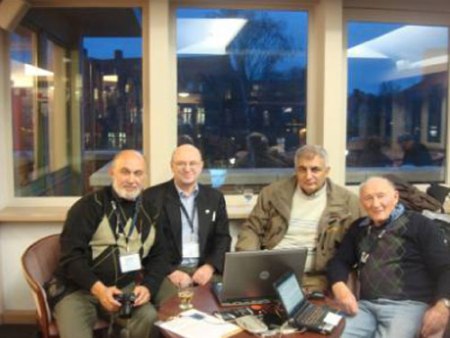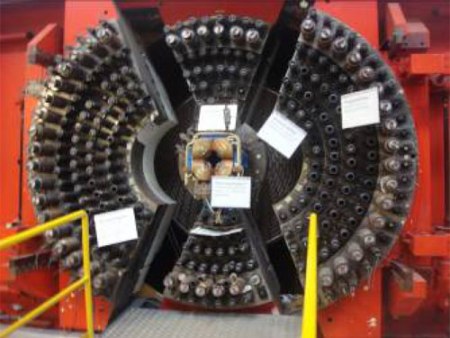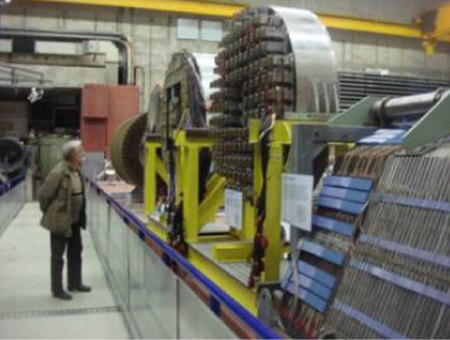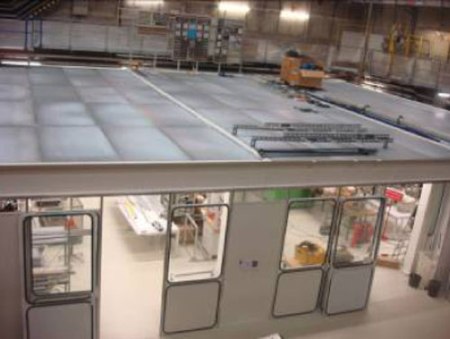
| 2009-11-30 04:52:06 |
Report on participation in the Management Committee Meeting of the COST Action ES0803 “Developing space weather products and services in Europe”, and the Sixth European Space Weather Week, Brugge, Belgium, and visit to DESY, November 15-25, 2009
COST is one of the European Union (EU) most successful instruments to promote scientific projects on the European level. There are hundreds of COST projects in numerous fields of science with thousands researchers from all the European and non-European countries (unfortunately only 2 from Armenia) making joint researches most important to the EU projects. Twice a year meetings are held for the COST country representative to exchange results and plan new investigations, short visits, etc. Recently a new program has launched for the young Phd, postdoctoral researchers: to provide up to 3,000 euro for participation in conferences. At the Brugge meeting the Cosmic Ray Division (CRD) was accepted as non-COST institutes to join the ES0803 Action. The COST Action also planned Space Weather School in Trieste in October 2010.
The traditional Space Weather week was also held in Brugge- an ancient Belgian town with old narrow streets and channels full of beautiful 3-storey old buildings and toll chapels (see CRD picture gallery for details). The conference was focused on the creation of the commercial Space Weather forecasting services, crucial for the Space Exploration. The motto of the conference was "To provide right information at the right time to the right people to make right decisions". Moving from physics to monitoring and forecasting.
Thomas J.Bogdan, director of the NOAA's Space Weather Prediction Center presented the joint NOAA-Air Force Weather Agency (AFWA) Space Weather Prediction Testbed project, a numerical heliospheric solar storm propagation model (the GeospaceResponse Model - GRM), that will dramatically enhance the lead time for the prediction of the onset of geomagnetic storms from the current 20 to 50 minutes, provided by NASA's Advanced Composition Explorer spacecraft, out to one to four days.
The GRM consists of the following parts:
- Solar Wind Disturbance;
- Energetic ParticleTransport;
- Solar Irradiance Prediction;
- Magnetograms simulation – likelihood of the Solar Flares;
- Solar general Circulation Model.
Ability to respond to the space weather community expeditiously and build a strong trust relationship within the community was planned by 2012. Transition from models design, verification and validation to commercial operation was planned in 2010-2018.
Director of the ESA’s Space Situational Awareness (SSA) Project, J.P.Luntama, informed that the overall objective of the project is to provide timely and quality data, information, services and knowledge regarding the environment, the threats and the sustainable exploitation of the outer space surrounding the planet Earth. SSA serves to the implementation of the strategic missions of the European Space Policy based on the peaceful uses of the outer space by all states, by supporting the autonomous capacity to securely and safely operate the critical European space infrastructures. The SSA preparatory program started in 2009 and will continue until 2011. The aim of the preparatory program includes a number of precursor services in the areas of Space Surveillance,Space Weather and Near Earth Objects (NEOs). The Space Weather (SWE) segment of the SSA will provide user services related to the monitoring of the Sun, the solar wind, the radiation belts, the magnetosphere and the ionosphere. These services will include near real time information and predictions about the characteristics of the space environment and space weather impacts on man- made systems, and a permanent database for analysis, model development and scientific research. These services are aimed at supporting, for example, spacecraft designers, spacecraft operators, human space flights, users and operators of transionospheric radio links, other SSA segments, and the space weather research community. The precursor SWE services will include a selected subset of these services based on pre-existing space weather applications. Spanish, French and German Space Weather programs were also presented. At the poster session numerous facilities and methods were presented and discussed. I presented the concept and the first results of the SEVAN world-wide network of hybrid particle detectors, measuring 3 species of the secondary cosmic rays.The considerable advantage of SEVAN type detectors upon the 60 years oldneutron monitors is as follows:
- Enlarged statistical accuracy of measurements;
- Probe different populations of primary cosmic rays with rigidities from 7 GV up to20-30 GV;
- Reconstruct SCR spectra and determine position of the spectral “knees”;
- Classify GLEs in “neutron” or “proton” initiated events;
- Estimate and analyze correlation matrices among different fluxes;
- Significantly enlarge the reliability of Space Weather alerts due to detection of 3 particle fluxes instead of only one in existing neutron monitor and muon telescope world-wide networks.
- Detection of electrons and gamma-quanta from showers generated by powerful natural accelerators operating during thunderstorms – research of Detection of operation of the relativistic feedback accelerator in low atmosphere.
During the conference we also performed several meetings with Rainer Hippler, Lev Dormanand Lev Pustil’nik to form a consortium for the new FP7 programme on the SpaceWeather forecasting based on SEVAN network.

|
 Figure 2 The ARGUS magnet to be dismounted by Armenian group. |
At DESY I conducted several meetings with DESY directorate members, met HERMES, H1groups, examined the ARGUS detector dismounted by the YerPhI technicians and gave a seminar on the recent cosmic ray research.
During the meetings with new DESY research director Joachim Mnich and deputy research director Manfred Fleischer the ongoing joint projects were discussed and a firm intention to continue and enlarge the collaboration between YerPhI and DESY was confirmed. YerPhI got invitation to actively participate in the last high energy physics experiment at DORIS rings - the OLYMPYS* experiment.The funds from EU and USA are already allocated, the preparatory works already started (by YerPhI group), MOU planned to be signed in the end of 2009 and experiment is planned at 2012. By that time a lot of preparatory simulations should be done to be sure that all parameters of experiment are chosen optimally. 2012 is the last year of DORIS operation, therefore, therewill be no time to reuse the beam and correct possible mistakes. A decision was made to donate YerPhI large computer cluster for the GRID operation. The transportation of computers is planned for the Spring 2010.
During the meeting with the former chair of DESY Directors board Albrecht Wagner we discussed the situation in YerPhI after external board meeting in July 2009. Albrecht Wagner, one of the most active commission members, once again emphasized the necessity to urgently form a Permanent External Board for YerPhI. He claimed that without this board he will not be able to run DESY.During the visit to the HERA west hall the exhibition of the HERA experiments detectors and the new workshop for particle detector assembling were demonstrated to me. During recent “open doors” at DESY more than 13,000 Hamburg citizens visited the specially prepared expositions at DESY. It is a good example for YerPhI: we have to prepare the exhibition of our facilities, invitestudents from all the Armenian universities and schools to interest the new generation in high energy physics. As opposed to YerPhI the age structure of DESY is balanced and they have no problems to incorporate students in current activities.

|
 Figure 4. New detector assembling workshop, placed in the hall cleaned in 2008 by YerPhI technicians |
* Striking differences have been observed in the ratio between the electric and magnetic proton form factors as function of Q2, either from measurements using the Rosenbluth separation method or using polarisation transfer. Two-photon exchange (TPE) effects are one possible explanation for this discrepancy. The most elegant and direct way tomeasure the TPE is to measure the ratio of elastic electron-proton and positron-proton cross-sections, where the contribution enters with a different sign.Such an experiment, now named OLYMPUS, has been proposed to be performed at the DORIS storage ring at DESY utilizing the BLAST detector. The details of experiment and YerPhI participation in it will be presented by N.Akopov in Spring 2009.
